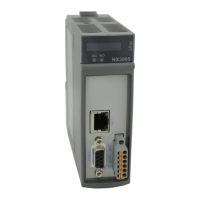6. REDUNDANCY WITH NX3030 CPU
Return to the Inactive state, if determine failure types remain
Return to the Not-Configured state, in case of other failure types
Go to Stand-by state, if the other CPU is in Active state
Go to Active state, if the other CPU isn’t in Active state
6.3.16. PX2612 Redundancy Command Panel Functions
The PX2612 redundancy command panel is shown on Figure 167, while Figure 168 shows its frontal view with more
details. Besides this, Figure 169 shows how this panel must be connected to the PLCA and PLCB half-clusters.
The PX2612 is divided in two sections: one controlled by PLCA and another by PLCB. These controllers are possible
through cables AL-2317/A for PLCA and AL-2317/B for PLCB, and allow each CPU to read three buttons, write on three
LEDs and a NO relay contact.
Observing the frontal view on Figure 168:
PLCA executes the STAND-BY and INACTIVE buttons reading in PLC A sector
PLCA executes the TURN ON PLC B button reading
PLCA executes the writing on the three LEDs (ACTIVE, STAND-BY and INACTIVE) from the PLC A sector
PLCA executes the writing on the RL B relay, used to switch off PLCB
PLCB executes the STAND-BY and INACTIVE buttons reading in the PLC B sector
PLCB executes the TURN ON PLC A button reading
PLCB executes the writing on the three LEDs (ACTIVE, STAND-BY and INACTIVE) from the PLC B sector
PLCB executes the writing on the RL A relay, used to switch off PLCA
6.3.16.1. PX2612 Buttons
This section describes the functions of the PX2612 buttons.
The STAND-BY button has the following functions:
To request a switching from the Active state to the Stand-by state, useful when maintenance in the Active CPU is needed.
After the Active CPU is switched to Stand-by (and consequently the Stand-by CPU is switched to Active), it’s possible
to switched from Stand-by to Inactive using the INACTIVE button, and then execute the programmed maintenance in
the inactive state
To request a configuration which causes a switching from the Not-Configured to the Starting state, typically after the
failures that caused the transition to the Not-Configured state are repaired. After the Starting state, normally the CPU is
supposed to go to the Stand-by state (or Active, if the other CPU isn’t in the Active state)
To request a switching from the Inactive state to the Not-Configured state requesting a configuration already. This occurs
typically after the failures which caused the transition to the Inactive state were corrected. After the Not-Configured state,
the configuration must take it to the Starting state. After the Starting state, normally the CPU is supposed to go to the
Stand-by state (or Active, if the other CPU isn’t in the Active state)
The INACTIVE button requests a switching from the Stand-by state to the Inactive state, which can be useful to execute
a programmed maintenance in the Stand-by CPU. After this maintenance, the STAND-BY button may be used to make it
go back to the Stand-by state, passing by the Not-Configured and Starting state (see previous description of the STAND-BY
button).
The TURN ON PLCx (x = B for PLCA, or x = A for PLCB) button is used to cause a reactivating in the other CPU, in case
the local CPU has switched off. As it is described in the Transition between Redundancy States section.
There are exceptional situations when a CPU switches off the other at assuming the Active state, in order to avoid the
possibility of both CPUs to assume the Active state simultaneously.
ATTENTION
For a button to be considered, it must be pressed for at least 1 second. Furthermore, during
this second, only this button must be pressed (the other 2 buttons must be released).
ATTENTION
There are alternative ways to generate the same effects of the STAND-BY, INACTIVE and
TURN ON PLCx buttons. Commands generated by the local CPU or the remote CPU can
be used, as described, preliminary, in the Diagnostics, Commands and User Data Structure
section. A more detailed description of these commands can be found in the Redundancy
Commands section.
295

